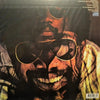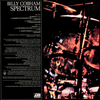









Billy Cobham - Spectrum (Translucent Red vinyl)
ORDER LIMITED TO ONE ITEM PER CUSTOMER
Billy Cobham - drums, percussion, production
Tommy Bolin (A1, A5, B1, B5) - guitar, Echoplex [click here to see other vinyl featuring Tommy Bolin]
Jan Hammer - electric and acoustic pianos, Moog synthesizer
Lee Sklar - electric bass (A1, A5, B1, B5)
Joe Farrell (A3, B3) - soprano and alto saxes
Jimmy Owens (A3, B3) - flugelhorn, trumpet
John Tropea - guitar (B3)
Ron Carter - acoustic bass (A3, B3) [click here to see more vinyl featuring Ron Carter]
Ray Barretto – congas (A3, B3)
All songs written and composed by Billy Cobham
1 LP, Gatefold Cover
Limited edition
Original analog Master tape : YES
Heavy Press : 180g
Record color : Translucent Red
Speed : 33RPM
Size : 12”
Stereo
Studio
Record Press : unspecified
Label : Friday Music
Original Label : Atlantic
Recorded May 14–May 16, 1973 at Electric Lady Studios, New York City
Mixed at Trident Studios, London
Engineered by Ken Scott (recording and re-mix engineering)
Produced by Billy Cobham
Originally released in October 1973
Reissued in February 2024
Tracks:
Side A:
- Quadrant 4
- Searching For The Right Door
- Spectrum
- Anxiety
- Taurian Matador
Side B:
- Stratus
- To The Women In My Life
- Le Lis
- Snoopy's Search
- Red Baron
Reviews :
“Drummer Billy Cobham was fresh from his success with the Mahavishnu Orchestra when he recorded his debut album, which is still his best. Most of the selections showcase Cobham in a quartet with keyboardist Jan Hammer, guitarist Tommy Bolin, and electric bassist Lee Sklar. Two other numbers include Joe Farrell on flute and soprano and trumpeter Jimmy Owens with guitarist John Tropea, Hammer, bassist Ron Carter, and Ray Barretto on congas. The generally high-quality compositions (which include "Red Baron") make this fusion set a standout, a strong mixture of rock-ish rhythms and jazz improvising.” AllMusic Review by Scott Yanow
“Miles Davis, The Mahavishnu Orchestra... this American drummer was the first to fuse jazz with rock and, with his debut solo album, the first to take this freshly forged genre into the charts. His percussion powered one of Massive Attack's smash hits too...
William E Cobham Jr was born in Colón on the Caribbean coast of Panama in 1944. His mother was a singer and his father worked as a hospital statistician, but he also played piano at weekends. As such, Billy grew up listening to jazz, classical and Latin music.
In 1947 the family decamped to Brooklyn, New York, where, aged just four, the young Cobham began drumming, making his live debut at the ripe old age of eight when his father's drummer failed to turn up.
At the age of 14, Cobham passed an audition for New York's High School Of Music And Art. He was drafted into the US army in 1965 and his musical skills gave him the option of playing in an army band rather than going into combat.
Dreams Are Made
In 1968 Cobham secured his first jazz gig, in legendary pianist Horace Silver's trio, and thereafter his career really took off. He was an in-demand session player and formed the jazz-rock band Dreams in 1970 with horn players Michael and Randy Brecker and guitarist John Abercrombie.
However, his big break came with Miles Davis. He played on the sessions for 1970's epochal jazz-rock album Bitches Brew – appearing on 'Felo', an outtake released on the 1999 reissue – and on Live-Evil and Jack Johnson (both recorded in 1970 but released in 1971).
'[Miles] was a strong manager of musicians', Cobham said in 2014. 'He knew who to put with whom to play what. It was probably the biggest lesson I learnt: just watching how he shuffled around the pawns, to get the effect he was looking for.'
Although Cobham only played briefly with Miles it was a particularly important time as it was at the sessions he met guitarist John McLaughlin. In 1971 the drummer played on McLaughlin's eastern-inspired acoustic album My Goal's Beyond with violinist Jerry Goodman. With the addition of Jan Hammer on keyboards and Rick Laird on bass guitar, this lineup grew into The Mahavishnu Orchestra.
As with most music that becomes influential, the musicians involved are too busy making it to reflect on how it might fit into the history – or future – of music. These were the early days of jazz-fusion or jazz-rock and Cobham has since admitted that although he liked the band's music he doubted anyone else would.
Bitches Brew still sounds unique and difficult to classify today; it was coming from jazz, but infused with rock and funk elements. And while the music had been guided by Miles Davis's imperious and enigmatic presence, in The Mahavishnu Orchestra the feeling was more of exploration as a group of peers.
Explosive Breaks
Their debut LP, The Inner Mounting Flame, which arrived in 1971, was music that had come from jazz but was going right over into rock territory, and in terms of musicianship the group raised the bar beyond the reach of most. 'Mahavishnu' was the name McLaughlin adopted as a disciple of Indian spiritual leader Sri Chinmoy. The guitarist – who took to wearing all white – pointed his guitar heavenwards and played ecstatically and at thrilling velocity with a searing, distorted tone.
Galvanised by this new company, Cobham developed his drum style by taking the swing and rhythmic invention of jazz and imbuing it with the power of rock, his playing punctuated by explosive breaks. The band exuded an air of spirituality but played with a visceral intensity that was rare in either rock or jazz. There hadn't been anything quite like it before and McLaughlin and Cobham, in particular, spawned many imitators. Yet few musicians ever managed to achieve their level of inspired virtuosity.
Too Dangerous
In 1971, Ken Scott was working as an engineer with producer Gus Dudgeon on Elton John's Honky Chateau and Elton was enthusing about The Inner Mounting Flame. Scott didn't really get it to start with, but when The Mahavishnu Orchestra asked him to engineer their second album Birds Of Fire, at Trident studios in London in 1972, he gave the album a serious re-listen and was converted. 'It blew my mind – the energy, just everything about it', he said later. 'That energy continued all the way through, it almost became too dangerous for them.'
The group only lasted for about two-and-a-half years and Cobham has noted that while the musicians were drawn to each other like 'magnets' and produced some extraordinary music, they didn't have a great deal in common as people. And when disputes arose about McLaughlin taking all the compositional credit, the atmosphere became toxic.
Cobham realised that McLaughlin was going to dissolve the group and so he had secured a solo deal with Atlantic, assembling a band around himself and Jan Hammer, with Scott again asked to engineer. He describes his mood as one of desperation and that he needed to make an album that could at least be a 'calling card' for his abilities.
Flying High
'It was a natural transition for me', Cobham would say about his approach on Spectrum. 'We heard very strongly and very equally the rock 'n' roll situation as it tied into classic jazz. So it was very easy to combine the two if you were comfortable. And that's all it is. Fusion is a melting pot of different ideas that stem from what is considered jazz.'
And the stylistic fusion essentially came from the players Cobham had assembled. On bass was the talented session musician Lee Sklar and the rock element was provided by 21-year-old guitarist Tommy Bolin, a flash, flamboyant player who Cobham had first met in 1969, and who had recently joined The James Gang.
As Lee Sklar said: 'There was a sort of fire in it. It was new ground and it wasn't very analytical. It was more flying by the seat of your pants'.
The rockier tracks on Spectrum on which Bolin lets fly in spectacular fashion include 'Quadrant 4' and 'Taurian Matador', but Cobham showed himself to be a talented arranger and melodic writer across a number of musical styles.
On The Attack
The title track is based on an intricate shuffle rhythm with Miles Davis alumnus Ron Carter on bass and some delicious horn arrangements. Then there's 'Le Lis', which has a sinewy Latin groove garnished by Joe Farrell's flute melodies. 'To The Women In My Life', on the other hand, is a lyrical piano vignette written by Cobham but played by Hammer.
But the most famous track on Spectrum is 'Stratus', which rides out on Sklar's cyclical bass line over which Cobham plays a silky funk groove punctuated by spectacular drum breaks, with each beat delivered at mind-boggling speed.
When Cobham was interviewed in 2018 and quizzed about the number of times his music had been sampled, he seemed to have no idea that there were over 100 instances. 'I'm pretty comfortable with it', he replied, 'it's like involuntary advertising'. The most famous example of this is Massive Attack's 1991 international hit single 'Safe From Harm', on which the bass and drums on 'Stratus' are sampled and looped to fine effect.
Yet some pundits at the time criticised Cobham's playing for being too upfront, implying a drummer should know their place. 'I went, "No, this is me. Like it or lump it"', he told the FT in 2014.
Initially Cobham wondered if Spectrum might sell only 500 units, but it became the first drummer-led album to reach No 1 in the Billboard jazz charts. More surprisingly for an instrumental fusion album it hit No 26 in the Hot 200, and endures to this day as a classic of its genre.” Mike Barnes, hi-finews, 17, 2022
Ratings :
AllMusic : 5 / 5 , Discogs : 4.35 / 5



